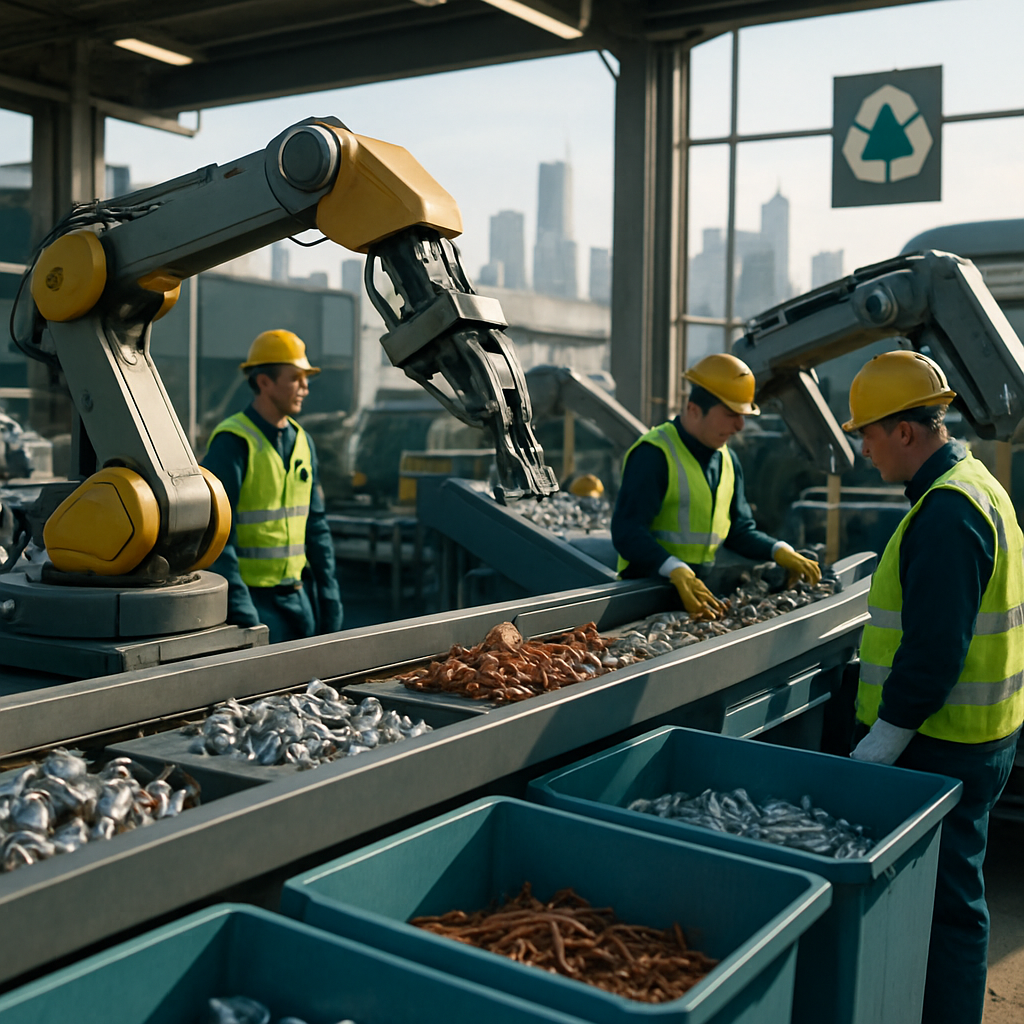5901 Botham Jean Blvd, Dallas, TX 75215
Metal Management: Sorting, Recycling, and Resource Recovery Strategies
September 17, 2025As sustainability gains global importance, metal management emerges as a pivotal environmental practice. This involves the systematic processes for handling, sorting, and recycling metal waste from manufacturing, construction, and other industrial activities.
Metal management goes beyond mere disposal. It entails comprehensive strategies for collecting scrap metal, sorting different types, processing them properly, and reintegrating these valuable materials into production cycles. This approach supports a circular economy where metals can maintain their utility indefinitely.
The primary goal of effective metal management is to minimize landfill waste while maximizing the recovery of valuable ferrous metals (containing iron) and non-ferrous metals (like aluminum, copper, and brass). The practice offers significant environmental and economic benefits, making it essential for industries committed to sustainability and resource conservation.
What are the Key Components of Metal Management?

Effective metal management requires a systematic approach to maximize resource efficiency while minimizing environmental impact. The metal recycling industry has developed several key strategies to create a comprehensive waste management system. Let’s examine these critical components in detail.
Waste Minimization at the Source
The most effective way to manage metal waste is to prevent its generation. This approach focuses on optimizing manufacturing processes to reduce scrap and off-cuts during production.
Industries can implement precision cutting technologies and automated systems to minimize material waste. For example, sheet metal fabricators now use computer-controlled cutting equipment that nest parts efficiently, reducing scrap by up to 30%.
Waste audits identify areas for optimizing material usage. Regular assessments of production processes enable companies to spot inefficiencies and implement corrective measures before waste accumulates.
Proper Segregation and Sorting
Once metal waste is generated, proper segregation is essential for effective recycling. Different types of metals require specific recycling processes, making accurate sorting crucial.
Modern facilities use several methods to separate metals effectively:
- Magnetic separation for ferrous metals like iron and steel
- Eddy current separation for non-ferrous metals such as aluminum and copper
- Optical recognition systems for more precise identification
- Metal-specific collection bins to prevent cross-contamination
Proper employee training is vital in this process. Staff must identify different metal types and understand the importance of keeping them separated to maintain material purity.
Recycling and Resource Recovery
The recycling process transforms metal waste back into usable raw materials, central to sustainable metal management with significant environmental benefits.
Metal recycling consumes substantially less energy than extracting and processing virgin materials. For example, recycling aluminum uses approximately 95% less energy than producing it from bauxite ore, translating to reduced carbon emissions and a smaller environmental footprint.
Resource recovery also involves extracting valuable metals from complex waste streams. Advanced technologies allow the recovery of precious metals from electronic waste, automotive components, and industrial byproducts.
Reuse of Metal By-Products
Many metal manufacturing processes generate by-products that still contain valuable materials. Instead of treating these as waste, effective metal management seeks ways to reuse them.
Slag and dross from metal refining can be reprocessed to extract remaining metal content. These materials also find applications in other industries – metallurgical slag, for example, is used as an aggregate in concrete production and road construction.
This approach creates additional revenue streams while reducing landfill waste. Companies implementing by-product reuse programs often report both environmental and financial benefits.
Waste-to-Energy Solutions
For metal-containing waste that cannot be effectively recycled or reused, waste-to-energy technologies provide an alternative to landfill disposal.
These processes convert waste materials into usable energy through methods like incineration or gasification. The heat generated can produce electricity or steam for industrial processes, creating value from otherwise unusable waste.
While waste-to-energy ranks lower on the waste hierarchy than recycling or reuse, it still offers environmental benefits over landfilling by reducing volume and recovering energy value.
By systematically implementing these components, industries can develop comprehensive metal management programs that reduce environmental impact, conserve valuable resources, and optimize operational costs. The circular approach to metal management ensures materials maintain their utility, moving away from the traditional take-make-dispose model.
How Does the Metal Recycling Process Work?
Metal recycling transforms discarded materials into valuable resources through a systematic process. This multi-stage journey begins with collection and ends with new products ready for market. Understanding each step helps us appreciate how metal recycling conserves resources while reducing environmental impact.
Collection: Where It All Begins
The metal recycling process starts with collection. Scrap metals come from various sources, including industrial facilities, construction sites, and household items. Materials range from old appliances and vehicles to plumbing fixtures and electronic components.
Businesses often designate specific bins for different metal types to streamline the sorting process. Some recycling facilities offer transportation services for large quantities of scrap metal, making collection more efficient for commercial clients.
Sorting and Segregation
Once collected, metals undergo thorough sorting. This critical stage separates ferrous metals (containing iron) from non-ferrous metals using magnets. Ferrous metals like steel stick to magnets, while non-ferrous metals such as aluminum and copper do not.
Modern facilities use advanced technology, including magnets, sensors, infrared scanning, and x-ray systems, to automate this process. These technologies can recover up to 95% of metals that might otherwise end up in landfills. Metals are further categorized by type, weight, and purity level.
Processing and Shredding
After sorting, metals are processed to reduce their size. Powerful hydraulic machinery compacts large pieces, while hammer mills shred them into smaller fragments. This step is crucial for two reasons: it makes transportation more efficient, and smaller pieces have a larger surface-to-volume ratio, which speeds up the melting process.
The size reduction also helps minimize energy consumption in subsequent stages. Different metals require specific processing methods based on their properties and intended applications.
Melting
The shredded metal enters large furnaces designed for specific metal types. Each metal requires different temperature settings based on its melting point. For example, zinc melts at a relatively low 419.5°C, while iron needs temperatures around 1,510°C.
This stage consumes significant energy but still requires far less than producing new metal from raw ore. The melting time varies from minutes to hours depending on the metal type and volume. The furnaces transform solid metal fragments into molten material ready for purification.
| Material | Energy Savings from Recycling | Environmental Impact Reduction | CO2 Emissions Reduction |
|---|---|---|---|
| Stainless Steel | 60-70% | Decreased energy consumption | 70-80% fewer emissions per tonne |
| Aluminum | 95% | Significant reduction in energy use | Can save up to 9 tonnes of CO2 emissions per tonne |
| Paper | Saves enough energy to power an avg. home for 6 months per tonne | 3.3 cubic yards of landfill space saved | Reduces emissions by 1 metric ton |
Purification
Molten metal contains impurities that must be removed to ensure quality. One common purification method is electrolysis, where an electric current passes through the metal. Pure metal deposits at the cathode while impurities settle as “anode mud” below.
For some metals, magnetic separation provides sufficient purification. This step ensures the recycled metal meets quality standards for manufacturing. The thoroughness of purification determines the grade and potential applications of the recycled material.
Solidification
After purification, the metal moves to cooling chambers where it solidifies into standardized forms. Manufacturers may add specific chemicals during this stage to create desired properties in the final product.
Common forms include ingots, bars, sheets, and blocks. This standardization makes transportation easier and helps manufacturers incorporate recycled metals into their production processes. The metal’s form often depends on its intended use in new products.
Transportation and Manufacturing
The final stage involves transporting the processed metal to manufacturing facilities. These recycled materials serve as raw inputs for creating new products, completing the recycling loop. Manufacturers can use these recycled metals just as they would virgin materials, with no loss in quality or performance.
This circular process significantly reduces the need for mining new ore, conserves natural resources, and decreases energy consumption. Steel recycling alone saves enough energy annually to power millions of households while conserving thousands of pounds of iron ore, coal, and limestone.
What are the Environmental Benefits of Metal Management?

Metal management is a powerful environmental practice that significantly benefits our planet’s health. When metals are recycled instead of discarded, they create a ripple effect of positive environmental outcomes that affect nearly every ecosystem.
Resource conservation is a fundamental benefit of metal management. Mining for virgin metal ores causes habitat destruction, soil erosion, and significant disruption to local ecosystems. By recycling existing metals, we dramatically reduce the demand for newly mined materials and protect natural landscapes from the harsh impacts of extraction activities.
Energy Conservation and Emissions Reduction
The energy savings from metal recycling are impressive. Processing recycled metal requires significantly less energy than extracting and refining virgin ores. Aluminum recycling saves up to 95% of the energy needed for new production, while steel recycling offers energy savings of about 60%.
These energy reductions directly decrease greenhouse gas emissions. According to the Environmental Protection Agency, metal recycling reduces greenhouse gas emissions by approximately 29 million tons of carbon dioxide annually – equivalent to removing 6.3 million cars from the road for an entire year.
Manufacturing products from recycled scrap metal generates far fewer emissions than using virgin materials. For instance, recycling one ton of aluminum can prevent up to nine tons of carbon dioxide emissions.
Pollution Reduction and Water Protection
Metal recycling significantly decreases various forms of pollution. Traditional mining and refining processes release harmful pollutants into air and water systems. The Northeast Recycling Council states that using recycled steel results in an 86% reduction in air pollution and a 76% decrease in water pollution.
Water conservation is another crucial benefit. The National Institutes of Health indicates that using scrap steel instead of virgin ore reduces water usage by 40%. Mining operations can contaminate waterways with heavy metals and toxic chemicals, while recycling metals minimizes these risks.
Landfill Waste Reduction
Metals take an extremely long time to decompose in landfills, with some persisting for hundreds or even thousands of years. By diverting metals to recycling facilities, we preserve valuable landfill space and prevent potential contamination issues.
Certain scrap metals contain hazardous substances like lead and mercury that can leach into soil and groundwater when improperly disposed of in landfills. Proper metal management ensures these materials are handled responsibly, protecting surrounding communities from environmental hazards.
Biodiversity Protection
Mining operations typically require clearing large areas of land, destroying natural habitats and disrupting local ecosystems. Metal recycling helps preserve biodiversity by reducing the need for new mining activities that would otherwise fragment habitats and threaten wildlife populations.
Beyond habitat preservation, metal management helps protect water resources that support diverse ecosystems. By reducing the pollution associated with metal extraction and processing, recycling helps maintain cleaner waterways that can support healthier and more diverse plant and animal communities.
What are the Economic Advantages of Metal Management?

The metal recycling industry serves as a robust economic engine, offering substantial financial benefits that extend beyond waste reduction. These advantages include job creation, significant cost savings, supply chain resilience, and operational efficiencies that benefit businesses and communities alike.
Job Creation Across Multiple Sectors
Metal recycling generates employment opportunities throughout the recycling supply chain. From collection specialists and truck drivers to processors and administrative staff, the industry provides diverse jobs for workers with varying skills and educational backgrounds.
Recycling facilities often create more jobs per ton of material processed compared to traditional waste management operations like landfills. The Institute of Scrap Recycling Industries reports that the recycling industry contributes over $105 billion annually to the U.S. economy.
These positions remain stable even during economic downturns, offering resilient employment to local communities. The diverse range of roles spans collection, processing, manufacturing, and administration, creating opportunities across multiple skill levels and sectors.
Cost Savings for Businesses
Companies implementing metal recycling programs gain immediate financial benefits, notably through reduced disposal costs. By diverting metal from waste streams, businesses lower their trash pickup and disposal fees.
Using recycled materials instead of virgin ore significantly reduces production expenses. For example, aluminum recycling requires only 5% of the energy needed for primary production. Steel recycling saves between 60% and 74% of the energy required to produce it from raw materials.
These energy savings translate directly to cost reductions, helping manufacturers maintain competitive pricing and stabilize budgets against volatile global metals markets. For manufacturing facilities producing substantial metal waste, these savings can be significant.
Revenue Generation Through Scrap Metal
Beyond cost savings, businesses can generate new revenue streams by selling scrap metal. Instead of paying to dispose of metal waste, companies can sell these materials to recycling facilities.
High-value metals like copper, aluminum, brass, and stainless steel often command premium prices in the recycling market. For manufacturers, construction companies, and automotive businesses, this “waste” represents considerable untapped value when properly sorted and recycled.
This transformation of waste into revenue exemplifies the circular economy model, where materials maintain their value through multiple lifecycles. Companies effectively turn a disposal cost into a profit center through strategic metal management.
Supply Chain Stability and Resource Security
Metal recycling enhances supply chain resilience by reducing dependence on raw material imports. This domestic supply of recycled metals helps shield businesses from international price fluctuations and supply disruptions.
While virgin material prices can swing dramatically with global supply chain issues, recycled materials typically offer more consistent pricing. This stability enables more accurate long-term financial planning and budgeting for manufacturers.
Recycled metals also provide a buffer against resource scarcity. As easily accessible ore deposits diminish, recycled metal becomes increasingly valuable as a reliable alternative supply source. This resource security represents a significant economic advantage for businesses in material-intensive industries.
Community Economic Benefits
The economic impact of metal recycling extends beyond individual businesses to strengthen entire communities. Recycling facilities contribute significant tax revenue through property taxes, income taxes, and business fees that support local government operations.
These facilities support a business ecosystem involving contractors, electricians, demolition crews, and transportation services. Their employees contribute through income tax payments, while broader economic activity generates sales tax revenue that funds essential community services.
By diverting metal from landfills, municipalities reduce waste management costs and extend landfill lifespans. The resulting environmental benefits also translate to economic advantages through reduced public health expenses and lower environmental remediation costs.
The metal recycling industry delivers powerful economic benefits that complement its environmental advantages. From job creation and cost savings to supply chain stability and community economic development, metal management represents a unique economic opportunity that aligns financial and environmental incentives.
Conclusion: The Future of Metal Management

Metal management stands at the intersection of environmental sustainability and economic prosperity. The recycling industry is evolving quickly with technological innovations that transform how we recover, process, and reuse valuable metals. Advanced sorting systems that utilize AI and robotics, improved recovery techniques, and blockchain technology for supply chain transparency are enhancing the efficiency of metal recycling operations.
The shift toward a circular economy is perhaps the most significant development in metal management. Urban mining initiatives are gaining momentum, with cities now seen as rich repositories of metals waiting to be reclaimed. This fundamental change from linear consumption to circular reuse conserves natural resources, reduces energy consumption, and cuts carbon emissions while creating economic opportunities through new jobs and industries.
For your metal recycling needs and to contribute to this sustainable future, contact Okon Recycling at 214-717-4083.
